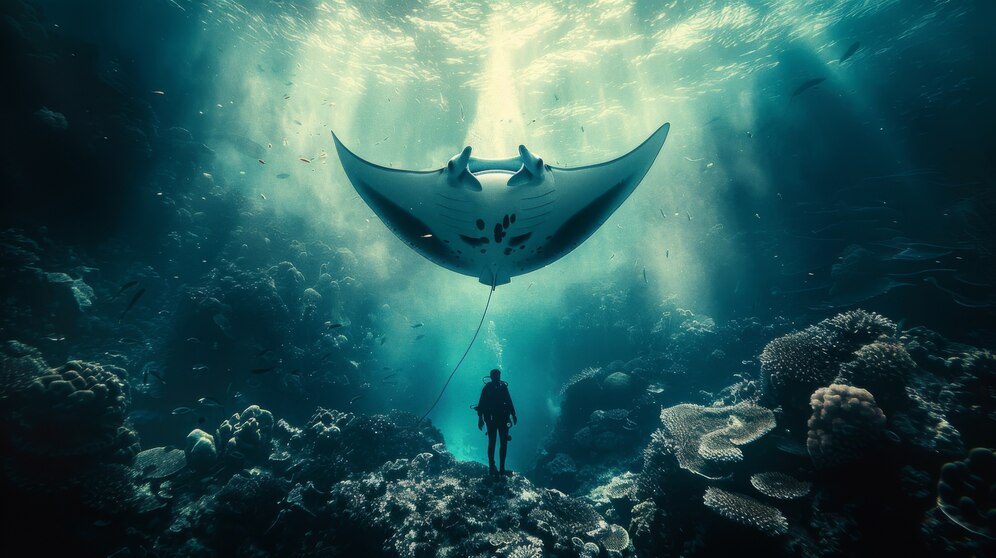Sea Inimes The ocean has long captivated humanity, with its deep blue expanse and diverse life forms. Among the myriad creatures that inhabit the sea, sea inimes is a term that encapsulates a broad range of marine organisms, each playing a pivotal role in the health and stability of the marine ecosystem. In this article, we’ll take a detailed look at what “sea inimes” are, their significance in marine ecosystems, the threats they face, and the steps being taken for their conservation.
What Are Sea Inimes?
The term “sea inimes” refers to a wide variety of marine organisms that live in, on, or near the sea. “Inimes” is an Estonian word meaning “human,” and in this context, it suggests the interconnectedness between human beings and the sea. Although the term may not be widely recognized globally, it represents the many life forms, ranging from microscopic plankton to giant marine mammals, that inhabit the ocean. These creatures are essential to the biodiversity of marine ecosystems, and they contribute significantly to the functioning of the world’s oceans.
Sea inimes include:
- Fish: These are perhaps the most familiar of sea creatures, ranging from small reef fish to large pelagic species like tuna and sharks.
- Mollusks: Creatures such as clams, oysters, squid, and octopuses fall under this category.
- Crustaceans: Lobsters, crabs, and shrimp are examples of crustaceans found in marine environments.
- Corals and Algae: While not animals, these photosynthetic organisms are vital to marine ecosystems, forming the foundation of food webs in coral reefs.
- Plankton: These are microscopic organisms, both plant-like (phytoplankton) and animal-like (zooplankton), that form the base of the marine food chain.
Together, these species are referred to as sea inimes and are an essential part of the ocean’s biodiversity.
The Importance of Sea Inimes in Marine Ecosystems
1. Nutrient Cycling and Food Webs
Marine ecosystems are highly interconnected, with various organisms depending on each other for food and survival. Sea inimes play a pivotal role in nutrient cycling and food webs. For example, at the very bottom of the food chain, plankton serve as the primary producers in the ocean, converting sunlight into energy. Phytoplankton, the plant-like plankton, perform photosynthesis, releasing oxygen and absorbing carbon dioxide. They are eaten by small fish, which are in turn consumed by larger fish and marine mammals.
This cycle helps maintain the flow of energy through the ecosystem. Small fish and zooplankton serve as the food base for larger animals, from mid-sized predators like dolphins to apex predators like sharks and whales. Each trophic level (feeding level) in this web is connected to the next, with sea creatures at every level contributing to the health of the ecosystem.
Without sea creatures, especially those at the base of the food web, marine ecosystems would collapse, and species higher up the food chain would suffer. The absence of these organisms could result in imbalances, such as algae blooms or starvation of larger species.
2. Coral Reefs and Biodiversity
These reefs provide habitats for thousands of species, ranging from fish to invertebrates like crustaceans and mollusks.
Corals also rely on the presence of zooxanthellae, a type of algae that lives symbiotically inside coral tissues. These algae perform photosynthesis, providing corals with the nutrients they need to grow and thrive. The abundance of marine life on coral reefs is made possible by the interaction of sea creatures like fish and invertebrates, which consume algae, keep the reef clean, and help recycle nutrients in the system.
However, coral reefs are highly sensitive to environmental stressors such as water temperature increases, ocean acidification, and pollution. Sea creatures like fish, mollusks, and crustaceans play crucial roles in maintaining the reef’s health, and their loss would have devastating effects on the entire ecosystem.
3. Economic and Cultural Importance
The economic importance of sea creatures cannot be overstated. Around the world, coastal communities rely on the sea for food, income, and cultural practices. Fisheries provide a significant portion of the world’s protein, with millions of tons of fish and shellfish harvested each year for human consumption. This supports industries like commercial fishing, seafood processing, and aquaculture, all of which provide jobs to millions of people globally.
Additionally, marine life plays a crucial role in the tourism industry. Activities like scuba diving, snorkeling, whale watching, and fishing expeditions draw millions of tourists annually, contributing billions of dollars to the global economy. In many tropical destinations, healthy marine ecosystems with abundant marine life are the primary drivers of tourism.
Marine life also holds cultural significance in many coastal communities. For instance, traditional fishing practices, as well as the symbolism of certain sea creatures, play a vital role in the heritage and cultural identity of many coastal populations.
Threats to Sea Inimes
While sea creatures are crucial to the health of the oceans, they face many threats due to human activities. These threats include overfishing, pollution, habitat destruction, and the effects of climate change. Understanding and addressing these threats is essential for the conservation of marine life.
1. Overfishing
This unsustainable practice leads to a depletion of fish stocks and disrupts the entire marine food web.
Overfishing also affects the creatures that depend on fish for food, such as seabirds, marine mammals, and larger fish species. Additionally, overfishing can result in bycatch – the unintended capture of non-target species such as dolphins, turtles, and seabirds, which can cause significant harm to these populations.
2. Pollution
Pollution, particularly plastic pollution, is one of the most significant threats to marine life. Millions of tons of plastic waste end up in the oceans each year, where it harms marine organisms in several ways.
Additionally, chemical pollution from agricultural runoff, sewage, and industrial waste can introduce harmful substances like pesticides, heavy metals, and oil into marine environments. These pollutants can disrupt ecosystems, contaminate food chains, and threaten the health of marine life, including the organisms that humans rely on for food.
3. Climate Change
Climate change is another significant threat to sea creatures. Rising global temperatures are causing ocean waters to warm, leading to a phenomenon known as coral bleaching. When corals become stressed due to temperature changes, they expel the algae living within their tissues, causing the coral to lose its color and become more vulnerable to disease. If ocean temperatures continue to rise, many coral reefs could disappear, taking with them the biodiversity that relies on these ecosystems.
Additionally, increasing carbon dioxide (CO2) levels are causing ocean acidification, which reduces the availability of calcium carbonate in seawater. This makes it harder for marine organisms like mollusks, corals, and some plankton to form their shells and skeletons, threatening their survival and the creatures that depend on them for food.
Conservation Efforts
Despite the numerous threats faced by sea creatures, efforts to conserve marine life are growing. Many organizations, governments, and communities are working together to protect sea inimes and their ecosystems.
1. Marine Protected Areas (MPAs)
MPAs serve as refuges for sea creatures, allowing them to thrive without the pressures of overfishing, pollution, or habitat destruction.
Research has shown that MPAs are highly effective at increasing biodiversity, improving fish stocks, and rebuilding damaged ecosystems.
2. Sustainable Fishing Practices
To ensure that fishing does not deplete marine populations, many organizations and governments are promoting sustainable fishing practices. This includes the use of eco-friendly fishing gear, the enforcement of fishing quotas, and the adoption of sustainable fishing methods like catch-and-release.
The implementation of marine stewardship programs and certification schemes, such as the Marine Stewardship Council (MSC), encourages the fishing industry to adhere to sustainable practices.
3. Reducing Pollution
Efforts to reduce ocean pollution are critical to the survival of sea creatures. Many organizations are working to reduce plastic waste by advocating for plastic bans, encouraging recycling programs, and cleaning up polluted areas. There is also a push to reduce chemical runoff from agriculture by promoting sustainable farming practices and reducing the use of harmful pesticides and fertilizers.
Governments and international bodies are also addressing oil spills and other forms of chemical pollution, working together to create regulations and action plans that minimize the impact of these disasters on marine life.
Conclusion
Sea creatures, or sea inimesed, play an indispensable role in the health of the oceans. From providing food and oxygen to maintaining the delicate balance of marine ecosystems, these organisms are critical to the survival of marine life and the wellbeing of the planet. However, human activities such as overfishing, pollution, and climate change are putting these creatures at risk. By understanding the importance of sea creatures and supporting conservation efforts, we can help preserve the oceans and ensure a sustainable future for marine life.
FAQs About Sea Inimes
1. What are sea inimes?
Sea inimes refers to a broad group of marine organisms, including fish, mollusks, crustaceans, corals, algae, and plankton. Which all play vital roles in maintaining the health of the ocean’s ecosystems.
2. Why are sea inimesed important?
Sea inimesed are crucial for nutrient cycling, food webs, biodiversity maintenance, and the overall health of marine ecosystems. They support the livelihoods of coastal communities and contribute to the global economy through industries like fishing and marine tourism.
3. What threats do sea inimes face?
Sea creatures face numerous threats, including overfishing, pollution (especially plastics), habitat destruction. And the effects of climate change, such as coral bleaching and ocean acidification.
4. How can we protect sea inimes?
We can protect sea creatures by creating more marine protected areas (MPAs), promoting sustainable fishing practices. Reducing pollution, and addressing the impacts of climate change.
5. How do sea inimes contribute to coral reefs?
Sea creatures, such as fish, mollusks, and crustaceans, help maintain coral reefs by keeping algae growth in check. Cleaning the reefs, and contributing to the nutrient cycles that support the health of the ecosystem.
6. What is the role of sea inimes in the food chain?
Sea inimes are integral to the marine food chain, with smaller organisms serving as food for larger predators. They help transfer energy through the ecosystem, keeping the marine food web balanced.
7. Can sea inimes help with pollution control?
Yes, certain marine organisms, such as filter-feeding mollusks. Help remove excess nutrients and debris from the water, promoting cleaner, healthier marine environments.






